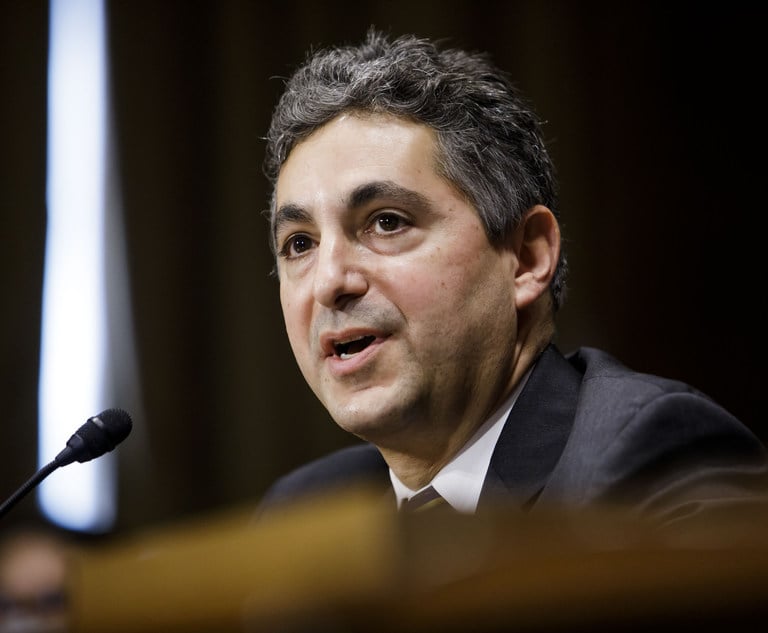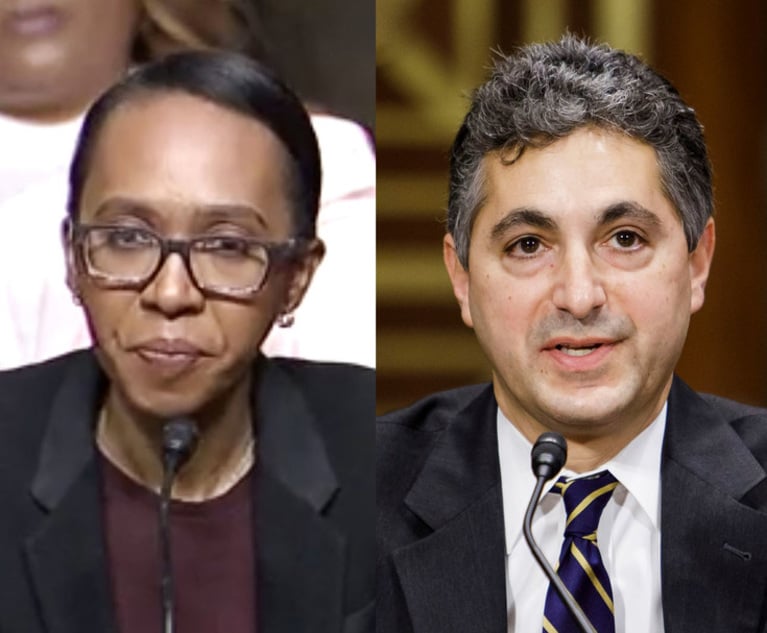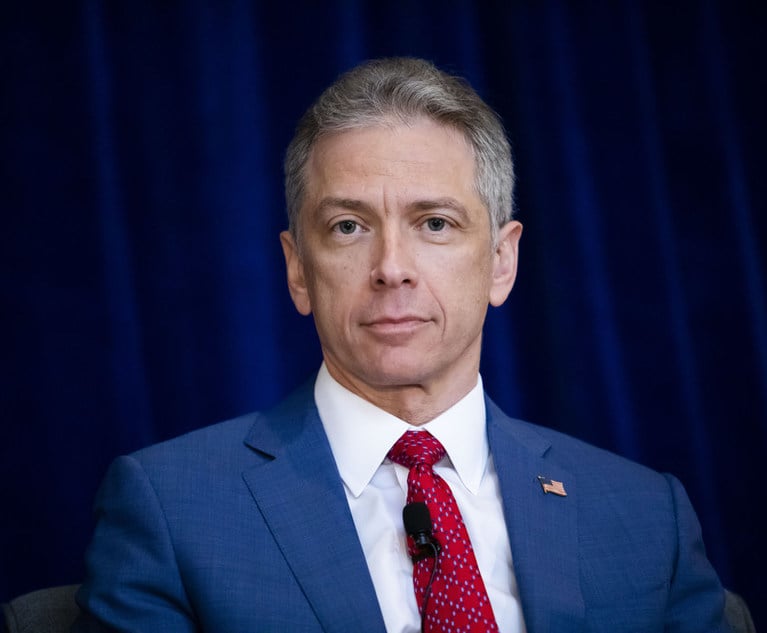Skilled in the Art: Supreme Court Calls on the Other SG + Quinn Scores Big Win in Hair Product Battle While Trying to Fend Off DQ Motion in Soccer Case
How often does the Supreme Court issue CVSGs twice in the same case? And does the SG ever change its mind? Twitter is rich with answers.
April 30, 2019 at 09:00 PM
9 minute read
Welcome to Skilled in the Art. I'm Law.com IP reporter Scott Graham. I heard the Supreme Court wanted the SG's views on Oracle and Google's mammoth copyright clash, so I've got 'em below. Oh wait, the Supreme Court wants to hear from the SG, the solicitor general, just as it did the first time around in 2015. It made me wonder: How often do the justices issue CVSGs twice in the same case? And does the SG ever change its mind? Thankfully, Twitter is rich with answers. Meanwhile, Quinn Emanuel pulled off a nifty feat, winning an injunction on a patent that the PTAB thinks is invalid. The firm is also fending off a disqualification motion in a high-profile battle between soccer nonprofits. I've got all the details below. As always you can email me your thoughts and follow me on Twitter.
➤➤ Would you like to receive Skilled in the Art as an email? Sign up here.
 Photo illustration by Jason Doiy.
Photo illustration by Jason Doiy.
Let's Hear From the Solicitor General—Again
In journalism we call it B matter. It's the background to a story that we write in advance of anticipated breaking news.
Ahead of the Supreme Court's April 26 conference, I wrote four separate sets of B matter based on what I saw as the most likely outcomes in Google v. Oracle, the copyright clash of Silicon Valley titans: One for cert denied. One for cert granted on Question 1 (whether copyright protection extends to Oracle's Java APIs). One for cert granted on Question 2 (whether a jury could find Google's copying a fair use). And one for cert granted on both questions.
I was all set. Once the Supreme Court announced its decision Monday morning, I would select the B matter that matched, hit “publish,” and my story would be online in minutes.
But there were two other possibilities. One was the court could have relisted Google's petition for a future conference. No big deal if that happened; I'd still be ready to go next time.
The other possible outcome was CVSG—a Call for the Views of the Solicitor General. Nahhhh, that wasn't gonna happen, right? The Supreme Court already got the SG's views in this case four years ago.
CVSG is what we got. Google and Oracle will once again have to make their pitches to the Justice Department's top Supreme Court litigator.
Matt Schruers of the Computer and Communications Industry Association had the same reaction as me:

It turns out two CVSGs in one case isn't that rare at all:


And as Fish & Richardson partner John Dragseth points out, the court has been requesting the SG's views a lot in IP cases lately.

The solicitor general is currently weighing recommendations on the Berkheimer and Vanda Section 101 cases, among several others.
The SG previously recommended in favor of Oracle on copyrightability. Does the office every change its mind on an issue? Once again, Twitter had an answer:. 
(Santos clarified that she was being hyperbolic with “billions,” but the Times storydoes show it's not that unusual.)
Chicago-Kent professor Edward Lee pointed out that the solicitor general doesn't even have to change its position to support Google. Although it rejected Google's arguments about copyrightability in 2015, “legitimate concerns with interoperability and lock-in effects are far better addressed through the fair-use doctrine,” the SG wrote then.
I asked Peter Menell, a Berkeley Law professor and Google amicus for his take. He notes the U.S. Copyright Office threw its support to Oracle the first time around, but is under new leadership now. “With the change in the Copyright Office GC, we might get a fresh/better look by the government,” Menell said via email.
There's one thing I know for sure: this long-running case has at least another year to go. The solicitor general's views will be due next fall, which means a decision won't likely come before next spring, as the case approaches its tenth anniversary. And if Oracle ends up winning at the Supreme Court, it means one more trial, one more appeal, one more cert petition … and maybe a third CVSG.
Future Brightens for Hair Treatment Case
Getting an injunction isn't easy in the post-eBay v. Mercexchange era.
But getting one on a patent that the Patent Trial and Appeal Board has declared invalid—now that's saying something.
A Quinn Emanuel Urquhart & Sullivan team led by partner Joe Paunovich pulled off the feat last week for Santa Barbara-based startup Olaplex LLC in a hard-fought battle with beauty giant L'Oreal USA Inc. The dispute is over what Olaplex calls“the holy grail of hair product development”—its bond building products that repair the breakage caused by bleaching.
U.S. District Judge Joseph Bataillon said last week that he will order three competing L'Oreal products off the shelves. He agreed with U.S. Magistrate Judge Sherry Fallon that the products likely infringe Olaplex's 9,498,419 patent. He also found that the patents will likely be found valid at trial, notwithstanding a PTAB decision last July to the contrary.
“Olaplex has made a strong case supporting validity at this point,” Battailon wrote. So long as the PTAB's decision remains on appeal, it “does not have preclusive effect as to this action unless and until the appeal is resolved,” he wrote.
The Federal Circuit is slated to hear the PTAB appeal next week. Olaplex has already had some success there: The appellate court ruled last year that now-retired U.S. District Judge Sue Robinson had construed Olaplex's patent too narrowly, and that Olaplex stood a good chance of winning an injunction under the proper construction. Now it has.
“It's been a long and hard-fought battle,” Paunovich said Monday. “We're very happy to get this result.”
L'Oreal and Olaplex are the No. 1 and 2 players in the product space, Paunovich said. But it's a long way down, in terms of resources, from L'Oreal, which reported about $30 billion in sales last year, to Olaplex, which was formed in a Santa Barbara garage and still numbers fewer than 30 employees.
L'Oreal is represented by Paul Hastings and Richards, Layton & Finger. They “heavily urged” Fallon to follow the PTAB's lead, Bataillon wrote in his order. L'Oreal told Fallon the PTAB decision and other developments had “unraveled” Olaplex's case.
“We're still a small startup company,” Olaplex Chief Legal Officer Tiffany Waldensaid Monday. “Getting this infringer off the market” will help Olaplex reclaim market share and grow its brand.
Soccer Federation Trying to DQ Quinn
You could see this one coming. When the United States Soccer Federation and the United States Soccer Foundation were closely aligned, Quinn Emanuel Urquhart & Sullivan prosecuted trademark registrations on behalf of both entities. After relations between soccer's governing body in the U.S. and the sport's charitable arm soured last fall, the foundation enlisted Quinn to sue the federation for a declaration of ownership.
“I'll bet they're none too pleased to see their former law firm on the complaint,” I wrote last December of the federation.
It turns out they're not. The federation moved to disqualify Quinn Emanuel and partner Robert Raskopf last month. “Quinn Emanuel and Mr. Raskopf previously represented before the U.S. Patent & Trademark Office that [the federation] owned and used the trademarks at issue in this action,” the federation's counsel at Crowell & Moring argue. But they “are now representing the Foundation in claiming these trademarks are solely owned and used by the Foundation.”
Quinn responded Thursday that Raskopf has been working with the foundation for nearly 30 years, and that “none of the grounds asserted by the [the federation] comes even close” to warranting disqualification.
To recap, the foundation has raised many millions of dollars for youth soccer since it was formed in the 1990s. The foundation has recently taken steps to establish its independence from the federation, and the parties dispute who controls marks such as the shooting ball logo combined with the words “U.S. Soccer Foundation.”
According to the disqualification motion, signed by Crowell partner David Ervin, Raskopf's relationship with the federation dates all the way back to the 1980s. The federation didn't pay him to prosecute the foundation's marks, but “authorized” the foundation to do so on the federation's behalf. Quinn and Raskopf filed declarationsand renewals that “unequivocally identify” the federation as the applicant, registrant and owner of the marks, the motion states.
“By now taking a contrary position in this suit, Mr. Raskopf and Quinn Emanuel are going directly against the interests of their former client—and their own filings before the USPTO,” Ervin states.
Quinn Emanuel's response, signed by associate Scott Lerner, calls the motion a diversionary tactic. The firm argues that Raskopf wasn't privy to any confidential information that would put the federation at a disadvantage in litigation. The public nature of trademark prosecution “strongly refutes any inference that confidential information would be disclosed during the course of the representation,” the motion states.
Raskopf has been working with the foundation since the 1990s, Lerner writes. The federation's “ploy to undermine Mr. Raskopf's relationship with the Foundation, his client of many years, by claiming he represents the USSF (his firm's adversary) should be seen for what it is.”
That's all from Skilled in the Art for today. I'll see you all again on Friday.
This content has been archived. It is available through our partners, LexisNexis® and Bloomberg Law.
To view this content, please continue to their sites.
Not a Lexis Subscriber?
Subscribe Now
Not a Bloomberg Law Subscriber?
Subscribe Now
NOT FOR REPRINT
© 2025 ALM Global, LLC, All Rights Reserved. Request academic re-use from www.copyright.com. All other uses, submit a request to [email protected]. For more information visit Asset & Logo Licensing.
You Might Like
View All
Skilled in the Art With Scott Graham: I'm So Glad We Had This Time Together

Design Patent Appeal Splinters Federal Circuit Panel + Susman Scores $163M Jury Verdict + Finnegan Protects Under Armour's House
Trending Stories
Who Got The Work
J. Brugh Lower of Gibbons has entered an appearance for industrial equipment supplier Devco Corporation in a pending trademark infringement lawsuit. The suit, accusing the defendant of selling knock-off Graco products, was filed Dec. 18 in New Jersey District Court by Rivkin Radler on behalf of Graco Inc. and Graco Minnesota. The case, assigned to U.S. District Judge Zahid N. Quraishi, is 3:24-cv-11294, Graco Inc. et al v. Devco Corporation.
Who Got The Work
Rebecca Maller-Stein and Kent A. Yalowitz of Arnold & Porter Kaye Scholer have entered their appearances for Hanaco Venture Capital and its executives, Lior Prosor and David Frankel, in a pending securities lawsuit. The action, filed on Dec. 24 in New York Southern District Court by Zell, Aron & Co. on behalf of Goldeneye Advisors, accuses the defendants of negligently and fraudulently managing the plaintiff's $1 million investment. The case, assigned to U.S. District Judge Vernon S. Broderick, is 1:24-cv-09918, Goldeneye Advisors, LLC v. Hanaco Venture Capital, Ltd. et al.
Who Got The Work
Attorneys from A&O Shearman has stepped in as defense counsel for Toronto-Dominion Bank and other defendants in a pending securities class action. The suit, filed Dec. 11 in New York Southern District Court by Bleichmar Fonti & Auld, accuses the defendants of concealing the bank's 'pervasive' deficiencies in regards to its compliance with the Bank Secrecy Act and the quality of its anti-money laundering controls. The case, assigned to U.S. District Judge Arun Subramanian, is 1:24-cv-09445, Gonzalez v. The Toronto-Dominion Bank et al.
Who Got The Work
Crown Castle International, a Pennsylvania company providing shared communications infrastructure, has turned to Luke D. Wolf of Gordon Rees Scully Mansukhani to fend off a pending breach-of-contract lawsuit. The court action, filed Nov. 25 in Michigan Eastern District Court by Hooper Hathaway PC on behalf of The Town Residences LLC, accuses Crown Castle of failing to transfer approximately $30,000 in utility payments from T-Mobile in breach of a roof-top lease and assignment agreement. The case, assigned to U.S. District Judge Susan K. Declercq, is 2:24-cv-13131, The Town Residences LLC v. T-Mobile US, Inc. et al.
Who Got The Work
Wilfred P. Coronato and Daniel M. Schwartz of McCarter & English have stepped in as defense counsel to Electrolux Home Products Inc. in a pending product liability lawsuit. The court action, filed Nov. 26 in New York Eastern District Court by Poulos Lopiccolo PC and Nagel Rice LLP on behalf of David Stern, alleges that the defendant's refrigerators’ drawers and shelving repeatedly break and fall apart within months after purchase. The case, assigned to U.S. District Judge Joan M. Azrack, is 2:24-cv-08204, Stern v. Electrolux Home Products, Inc.
Featured Firms
Law Offices of Gary Martin Hays & Associates, P.C.
(470) 294-1674
Law Offices of Mark E. Salomone
(857) 444-6468
Smith & Hassler
(713) 739-1250










